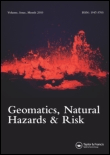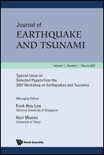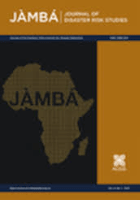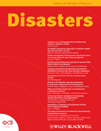
Geoenvironmental Disasters
Scope & Guideline
Connecting disciplines to tackle geoenvironmental risks.
Introduction
Aims and Scopes
- Natural Hazard Assessment:
The journal investigates various natural hazards, including landslides, earthquakes, floods, and tsunamis, emphasizing the importance of understanding their causes, mechanisms, and consequences. - Disaster Mitigation Strategies:
Research published in the journal often explores innovative mitigation measures, including nature-based solutions and engineering approaches, aimed at reducing the impact of natural disasters on communities and infrastructure. - Technological Innovations:
The journal highlights the application of advanced technologies such as machine learning, remote sensing, and GIS in understanding and predicting natural hazards, enhancing the capability for real-time monitoring and response. - Socio-Environmental Interactions:
A significant focus is placed on the interaction between human activities and environmental processes, including community-based approaches to disaster risk reduction and the role of social determinants in vulnerability. - Policy and Governance:
The journal also addresses the implications of disaster management policies and governance structures, analyzing their effectiveness in promoting resilience and sustainability in disaster-prone regions.
Trending and Emerging
- Machine Learning and Data Analytics:
There is an increasing focus on the application of machine learning and data analytics for landslide prediction, hazard mapping, and risk assessment, showcasing the potential of these technologies to enhance decision-making processes. - Nature-Based Solutions:
Research into nature-based solutions for disaster mitigation is gaining traction, reflecting a broader recognition of the effectiveness of ecosystem services in reducing the impacts of natural hazards. - Community Engagement and Social Resilience:
Emerging themes emphasize the role of community engagement in disaster risk reduction, highlighting how local knowledge and social networks can enhance resilience against natural disasters. - Climate Change Impacts:
The intersection of climate change and natural hazards is becoming a critical area of research, with studies exploring how shifting climatic conditions exacerbate the frequency and intensity of disasters. - Remote Sensing Technologies:
The use of remote sensing for monitoring natural hazards and assessing environmental changes is on the rise, indicating a trend towards integrating advanced technology for improved hazard management.
Declining or Waning
- Traditional Geological Assessments:
There has been a noticeable reduction in papers focusing solely on traditional geological assessments of hazards without integrating modern technological approaches. The trend is towards more interdisciplinary studies that combine geology with technology and social science. - Case Studies from Developed Regions:
The journal has seen fewer case studies focused on natural hazards in developed regions, indicating a potential shift towards addressing challenges in developing countries where the impacts of disasters are often more severe. - Static Risk Assessment Models:
Research utilizing static risk assessment models is becoming less frequent, as there is a growing emphasis on dynamic and probabilistic approaches that incorporate real-time data and predictive analytics. - General Overviews of Natural Hazards:
Papers providing broad overviews of natural hazards without specific case studies or detailed methodologies appear to be diminishing, as the journal favors more focused research with actionable insights and innovative methodologies.
Similar Journals

Bulletin of Engineering Geology and the Environment
Pioneering research for a sustainable geological future.Bulletin of Engineering Geology and the Environment, published by SPRINGER HEIDELBERG, is a leading journal dedicated to the fields of Geology, Geotechnical Engineering, and Engineering Geology. With an impressive impact factor placing it in the Q1 category for both geology and geotechnical disciplines, this journal is recognized for its significant contributions to the knowledge and application of engineering geology practices. Since its inception in 1984, the Bulletin has provided a platform for researchers and professionals to share cutting-edge research, case studies, and innovative methodologies relevant to the challenges of understanding and managing geological environments. With a robust Scopus ranking—#32/321 in Geology and #43/229 in Geotechnical Engineering—this journal is an essential resource for academics and industry leaders alike, striving to advance the environmental engineering field. For those interested in accessing the latest research and developments, the Bulletin fosters a collaborative and informed scholarly community.

Cuadernos de Investigacion Geografica
Exploring the Frontiers of Geography and Environmental ScienceCuadernos de Investigacion Geografica, published by UNIV RIOJA, SERV PUBLICACIONES, stands as a premier open-access journal dedicated to advancing knowledge in the fields of geography, environmental science, and earth sciences. Since its inception in 1983, this journal has fostered innovative research and critical discourse, currently holding a distinguished position in Scopus with impressive quartile rankings, including Q2 in both Earth and Planetary Sciences, and Geography, Planning and Development, reflecting its impact and relevance. With an aim to present high-quality, peer-reviewed articles that contribute to the understanding of our planet and its systems, Cuadernos de Investigacion Geografica welcomes submissions from researchers, professionals, and students alike, fostering a collaborative environment that spans across diverse geographical contexts. Operating from its hub in Logroño, Spain, this journal continues to be a vital resource for anyone engaged in geographical research and environmental analysis, providing open access to enhance knowledge sharing and innovation in these dynamic fields.

Australian Journal of Emergency Management
Pioneering insights in emergency management.The Australian Journal of Emergency Management, published by the Australian Emergency Management Institute, is a pivotal resource in the field of emergency management, public health, and safety research. With a history dating back to 1998 and a convergence period extending to 2024, this journal actively contributes to advancing knowledge and practice in emergency medical services and related areas. Holding strong positions in both the Q2 and Q3 quartiles of 2023 rankings, it stands out within its categories, particularly in Health Professions and Safety Research. While it is not an open-access journal, it provides essential insights and empirical research that are invaluable for researchers, professionals, and students alike. Located in East Melbourne, Australia, the journal ensures that critical advancements in emergency management and health are highly accessible to its global audience, fulfilling its mission to promote informed decision-making and improve community resilience during crises.

Risk Hazards & Crisis in Public Policy
Illuminating pathways to effective crisis management.Risk Hazards & Crisis in Public Policy is a leading academic journal published by WILEY, focusing on the interdisciplinary study of risks and crises as they pertain to public policy. Since its inception in 2010, this journal has established itself prominently in the field, currently holding a Q2 quartile ranking in Public Administration and boasting an impressive Scopus percentile of 89, ranking it 24 out of 232 journals in its category. This demonstrates its significant influence and relevance among peer-reviewed publications. The journal serves as a critical platform for researchers, policymakers, and practitioners to share innovative research, insightful analyses, and practical solutions related to the management and mitigation of risks in public administration. Although it does not currently offer open access options, it continues to provide vital insights into burgeoning issues within the domain, making it an essential resource for anyone interested in advancing their understanding of risk management in public policy contexts.

Geomatics Natural Hazards & Risk
Championing Open Access Research in Earth SciencesGeomatics Natural Hazards & Risk, published by TAYLOR & FRANCIS LTD, is a premier open-access journal that has been at the forefront of interdisciplinary research since 2010, addressing critical issues related to natural hazards and environmental risk management. With an impressive impact factor and ranking in the Q1 quartile in both Earth and Planetary Sciences and Environmental Science categories, this journal serves as a vital platform for researchers, professionals, and students dedicated to advancing knowledge in these fields. The journal's commitment to open access since 2016 ensures that its high-quality research is readily available to a global audience, fostering collaboration and innovation. Located in the United Kingdom, Geomatics Natural Hazards & Risk encompasses a broad scope of studies including geospatial technologies, risk assessment methodologies, and the societal impacts of natural disasters, making it an essential resource for anyone involved in the investigation and mitigation of natural hazards.

Journal of Earthquake and Tsunami
Advancing knowledge on seismic and oceanic forces.Welcome to the Journal of Earthquake and Tsunami, a premier scholarly publication dedicated to advancing the field of geophysical research, with a particular focus on seismic activity and tsunami phenomena. Published by World Scientific Publishing Co Pte Ltd, this journal provides a vibrant platform for researchers and practitioners alike to share their findings and innovations, contributing to the global understanding of these critical natural events. With an impact factor that reflects its relevance, the journal is categorized in Q3 quartiles for 2023 in areas including Geophysics, Geotechnical Engineering, and Oceanography, indicating a solid standing in the scientific community. It is indexed within Scopus, ranking in the upper half of its categories, which further establishes its importance as a resource for students and professionals seeking to stay informed about the latest developments. Although the journal operates under a traditional access model, its commitment to fostering scholarly discourse remains unwavering. Founded in 2008 and set to converge its offerings until 2024, the Journal of Earthquake and Tsunami continues to be an invaluable resource for anyone dedicated to understanding the dynamic and often dangerous interactions of our planet’s geological features.

Jamba-Journal of Disaster Risk Studies
Championing Safety through Collaborative Research.Jamba-Journal of Disaster Risk Studies, published by AOSIS, serves as a vital resource in the fields of management, monitoring, policy, law, and safety research, with an ISSN of 1996-1421 and an E-ISSN of 2072-845X. Since its establishment as an Open Access journal in 2006, Jamba has dedicated itself to disseminating high-quality research that informs and enhances disaster risk management practices, particularly within the South African context and beyond. With a robust Impact Factor and acknowledgement in the Q2 and Q3 quartiles across critical categories in 2023, Jamba ranks favorably in Scopus, notably Rank #50/109 in Social Sciences (Safety Research) and Rank #218/399 in Environmental Science (Management, Monitoring, Policy and Law). The journal's convergence over the years—from 2013 to 2024—signals its commitment to adapting contemporary challenges in disaster risk studies. Scholars and practitioners are encouraged to explore Jamba as a go-to platform for innovative insights and collaborative discussions that impact policy-making and practical applications in disaster risk reduction.

DISASTERS
Illuminating the complexities of disasters across disciplines.DISASTERS, published by WILEY, is a premier academic journal dedicated to advancing the understanding of disasters across multiple disciplines, including Earth and Planetary Sciences and Social Sciences. With a historical publication span from 1977 to 2024, this journal has established itself as a vital resource within the academic community, boasting a Q1 category ranking in both fields, indicating its high impact and relevance. DISASTERS ranks impressively in Scopus, holding the #27 position in General Social Sciences and #36 in General Earth and Planetary Sciences, reflecting its influence in shaping disaster research and policy. The journal serves as a platform for interdisciplinary collaboration, offering researchers, professionals, and students critical insights into disaster management, response strategies, and risk reduction measures. Although it is not an Open Access journal, DISASTERS remains a cornerstone for those looking to contribute to and stay informed about the evolving landscape of disaster studies.

Geographia Technica
Advancing Knowledge in Earth Sciences and PlanningGeographia Technica is an esteemed academic journal published by GEOGRAPHIA TECHNICA ASSOCIATION - GT Assoc in Romania, serving as a vital platform for the dissemination of cutting-edge research in the interdisciplinary fields of geography, planning, and earth sciences. Since its inception in 2009 and continuing through to 2024, the journal has established itself as a respected source of knowledge, reflected in its classification within the Q3 category across significant fields such as Computers in Earth Sciences, Earth-Surface Processes, and Geography, Planning and Development. With the ambition to enhance the understanding of socio-environmental interactions and technological applications in these areas, Geographia Technica invites scholars and practitioners to contribute original research that pushes the boundaries of current knowledge. Although currently not listed as open access, the journal's engaging content ensures it remains a valuable resource for researchers, professionals, and students keen on advancing their expertise in these dynamic disciplines.

Geofizika
Empowering Geophysics Through Open KnowledgeGeofizika, an esteemed journal published by the Andrija Mohorovičić Geophysical Institute at the University of Zagreb, presents a significant platform for research in the fields of geophysics and Earth sciences. With an Open Access model established since 1984, this journal ensures that scientific knowledge is accessible to a broad audience, encouraging collaborations and the free exchange of ideas. Geofizika has steadily evolved through its converging years from 1989 to 1999 and has been active from 2003 to the present, reflecting its commitment to advancing geophysical research. The journal has been recognized for its contributions to Earth and Planetary Sciences and has acquired respectable ranks in various categories; notably, it holds a Q4 status in Geophysics as of 2023. Researchers, professionals, and students will find Geofizika a valuable resource for the latest discoveries and methodologies in geophysics, supporting the academic community in expanding the frontiers of knowledge in these vital scientific domains.